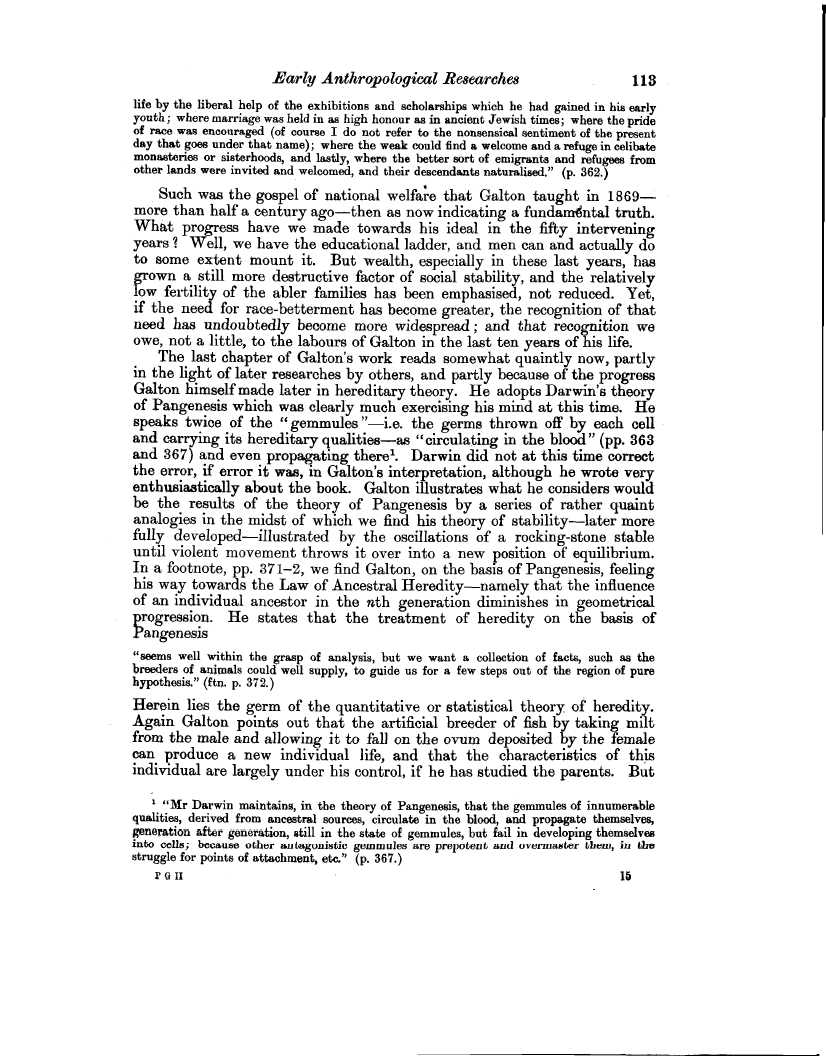Early Anthropological Researches 113
life by the liberal help of the exhibitions and scholarships which he had gained in his early youth; where marriage was held in as high honour as in ancient Jewish times; where the pride of race was encouraged (of course I do not refer to the nonsensical sentiment of the present day that goes under that name); where the weak could find a welcome and a refuge in celibate monasteries or sisterhoods, and lastly, where the better sort of emigrants and refugees from other lands were invited and welcomed, and their descendants naturalised." (p. 362.)
Such was the gospel of national welfare that Galton taught in 1869more than half a century ago-then as now indicating a fundamental truth. What progress have we made towards his ideal in the fifty intervening years? Well, we have the educational ladder, and men can and actually do to some extent mount it. But wealth, especially in these last years, has ~'own a still more destructive factor of social stability, and the relatively low fertility of the abler families has been emphasised, not reduced. Yet, if the need for race-betterment has become greater, the recognition of that need has undoubtedly become more widespread ; and that recognition we owe, not a little, to the labours of Galton in the last ten years of his life.
The last chapter of Galton's work reads somewhat quaintly now, partly in the light of later researches by others, and partly because of the progress Galton himself made later in hereditary theory. He adopts Darwin's theory of Pangenesis which was clearly much exercising his mind at this time. He speaks twice of the "gemmules "-i.e. the germs thrown off by each cell and carrying its hereditary qualities-as "circulating in the blood" (pp. 363 and 367) and even propagating there'. Darwin did not at this time correct the error, if error it was, in Galton's interpretation, although he wrote very enthusiastically about the book. Galton illustrates what he considers would be the results of the theory of Pangenesis by a series of rather quaint analogies in the midst of which we find his theory of stability-later more fully developed-illustrated by the oscillations of a rocking-stone stable until violent movement throws it over into a new position of equilibrium. In a footnote, pp. 371-2, we find Galton, on the basis of Pangenesis, feeling his way towards the Law of Ancestral Heredity-namely that the influence of an individual ancestor in the nth generation diminishes in geometrical progression. He states that the treatment of heredity on the basis of Pangenesis
"seems well within the grasp of analysis, but we want a collection of facts, such as the breeders of animals could well supply, to guide us for a few steps out of the region of pure hypothesis." (ftn. p. 372.)
Herein lies the germ of the quantitative or statistical theory, of heredity. Again Galton points out that the artificial breeder of fish by taking milt from the male and allowing it to fall on the ovum deposited by the female can produce a new individual life, and that the characteristics of this individual are largely under his control, if he has studied the parents. But
' "Mr Darwin maintains, in the theory of Pangenesis, that the gemmules of innumerable qualities, derived from ancestral sources, circulate in the blood, and propagate themselves, generation after generation, still in the state of gemmules, but fail in developing themselves into cells; because other antagonistic gemmules are prepotent and overmaster them, in the
struggle for points of attachment, etc." (p. 367.)
P G II 15

